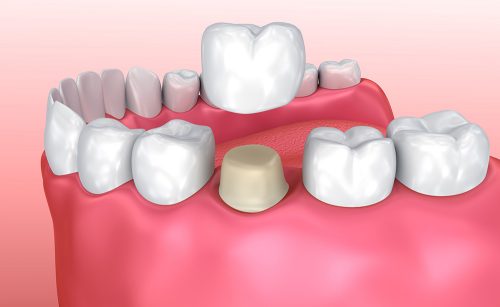Crowns
Crowns in Bradenton, FL
 Severe tooth decay can sometimes destroy a tooth to the point where a filling cannot keep it intact. Left untreated, these teeth can break down even further. In these cases, dentists rely on dental crowns to protect what’s left of the tooth.
Severe tooth decay can sometimes destroy a tooth to the point where a filling cannot keep it intact. Left untreated, these teeth can break down even further. In these cases, dentists rely on dental crowns to protect what’s left of the tooth.
Dental crowns are one of the most important restorations we offer. A crown can save a broken or decayed tooth by holding it together & protecting it from further damage. It can also serve as a beautiful replacement for an unsightly tooth.
A crown, also called a cap, is a good way to cover teeth that are discolored or badly shaped as well, or to cover a dental implant. A crown can make your tooth stronger & improve its appearance.
A crown acts the same way as a tooth, so after your crowns are placed, you should treat it the same way as well. Continue to brush & floss regularly & see your dentist for regular checkups!
What Is A Dental Crown?
In dentistry, a crown or a cap is a fake tooth that fits on top of a damaged tooth. They are custom-made to fit your smile & are built to last. There are a number of conditions that rely on crowns to save your teeth. You may even need a crown after undergoing certain dental treatments. A root canal or large filling can weaken an affected tooth & make it very vulnerable to cracking or breaking, so a crown is needed for protection. Crowns can also be used as a cosmetic treatment to improve the look of a misshapen or discolored tooth.
There are several types of crowns available to you, & each one varies in terms of appearance & strength.
Metal Crowns
Metal crowns are comprised of gold or other alloys (mixtures). They are the most durable type of crown available & the least likely to wear down your opposing teeth. The downside of metal crowns is that they do not blend into your smile, so you may not want them on your most visible teeth.
Ceramic Crowns
Ceramic crowns are made from porcelain & primarily used for their aesthetic qualities. They can be matched to the exact color of your teeth & are a great option for restoring your front teeth. However, they are the least durable crowns available. Porcelain can be too fragile to replace teeth that are put under a lot of strain, such as molars. They can also be rough on your other teeth.
Porcelain-Fused-to-Metal Crowns
Porcelain-Fused-to-Metal (PFM) crowns combine the qualities of ceramic & metal alloy crowns. With a porcelain exterior & a metal interior, these crowns are built for strength as well as looks. While boasting the best of both worlds, they also have drawbacks. The edge of the metal portion of the crown may become visible at your gum line, affecting its aesthetics. Additionally, the outer porcelain layer can wear down your other teeth or become damaged just like all-porcelain crowns.
Zirconia Crowns
Zirconia is a type of metal that is naturally tooth-colored, making it a popular crown material for many dentists. Like other metal crowns, it is also extremely durable. Unfortunately, zirconia is neither as aesthetically pleasing as porcelain nor as easy on the teeth as metal alloys.
Procedure Overview
Once we have determined the best kind of crown for you, we will schedule two appointments for you. During the first appointment, the dentist prepares your tooth for your custom-made crown. At the second appointment, they will permanently place the crown.
- Before the dentist can prepare your tooth for a crown, they will need to remove any tooth decay & perform fillings or root canals if necessary.
- Next, they need to remove enough of your tooth enamel for the crown to fit over it. You will receive local anesthesia to numb your tooth before the dentist begins to trim it down. The amount of tooth enamel that needs to be removed depends on which kind of crown you choose, with metal crowns requiring the least removal.
- Once your tooth has been prepared, we will take an impression (mold) of your teeth. The dentist will carefully pull the gums away from the prepared tooth using a small cord. Then you will need to bite down on putty-filled trays for a few minutes. This putty mold is sent to a lab, which will create an aesthetic match of your damaged tooth to fit comfortably alongside your original teeth. If you are getting a ceramic, porcelain-fused-to-metal or zirconia crown, the lab will match your crown to the color of your other teeth.
- The final step of your first appointment is getting a temporary crown. The dentist needs to place a temporary crown over the prepared tooth in order to protect it from any damage while you wait for your next appointment.
- It will take a couple weeks for the lab to craft your personalized crown. Once it is ready, you will come in for your second appointment so the dentist can make sure it fits comfortably & securely.
- When they find the right fit, they will permanently attach the crown with a bonding resin.
Dental crowns need to be treated with the same care as regular teeth. While the crown itself can’t decay, the tooth underneath it can. Regular brushing & flossing is essential to maximizing your crown’s lifespan. If properly cared for, a typical crown can last anywhere from 10 to 50 years!
Meet Your Award Winning Dentist

John Plumley, DMD

Natalie Platt , DMD




The Proof is in Our Patients

MOST INSURANCES WELCOME AND MAXIMIZED!
Contact us and schedule your visit today.
Most Insurances Welcomed and Maximized
Once you are enrolled, it’s easy to use your dental insurance. Simply choose a dentist & make an appointment! At South Bradenton Dental Care & Your Weekend Dentists®, we accept all major insurance provider plans, so you don’t have to worry about whether your insurance works here: It works great!

| Monday | 7:00 AM – 7:00 PM |
| Tuesday | 7:00 AM – 7:00 PM |
| Wednesday | 7:00 AM – 7:00 PM |
| Thursday | 7:00 AM – 7:00 PM |
| Friday | 7:00 AM – 12:00 PM |
| Saturday | 8:00 AM – 2:00 PM |
| Sunday | 8:00 AM – 2:00 PM |
